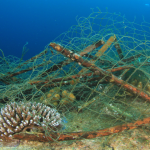Unpacking Food Packaging Waste: Insights from a Fremantle Beach Clean up
Read the latest news from Take 3 for the Sea Ambassador and Clipper Round the World Yacht Race crew member, Dianne McGrath.
We all have the ability to create a positive impact!
We made the most of the short stop in Fremantle, Western Australia during the Clipper 2023/24 Round the World Yacht Race to do a beach clean-up at South Beach. An early start on a warm Sunday morning saw a good turnout of dedicated volunteers from the Clipper Race crews, the Fremantle Sailing Club’s Marine Environment Committee (MEC) and the local All Abilities cricket club.
The MEC organises local beach clean-ups a few times a year as part of their program of environmental projects in the club. After the briefing from the MEC team, we split up and hit the beach and grassed picnic areas at South Beach to pick up litter. I started on the beach, first targeting the waterline then wandering up to the dune edges. I was delighted to observe that out of all the beaches I’ve cleaned during the Clipper Race to date, South Beach was the cleanest. Not that there was zero litter. I still collected items such as cigarette butts and small plastics. However, there was significantly less litter on the beach than every other beach I’ve cleaned as I’ve sailed round the world with the Clipper Race.
Furthermore, it was interesting to observe the change in the type of litter on South Beach compared to the adjacent grassed picnic area. While cigarette butts were still the most common item in both beach and grassed areas, the grassed area had a large amount of food related packaging waste. My PhD was in food waste and one of the many insights I gained from the research was that as the perceived value of an item of food diminished it was more likely to be thrown away or wasted. This was evident in the type of food packaging waste I picked up at South Beach. The primary packaging that held the food was rarely found in the grass but the pull tab, cap, ‘tear here’ strip or other ‘gateway’ packaging element were found in large numbers. The ‘gateway’ is the entry point to the desired food. I thought about the psychology behind this, hypothesising that the gateway items were preventing people getting to what they valued the most, that is the food. Perhaps this is one of the reasons these items were discarded with less thought than the primary packaging. Of course, these gateway packaging elements are also much smaller than the primary packaging holding the food, so they could also more easily be accidentally dropped or blown away. I’ll be interested in continuing to explore this issue once the Clipper Race is over.

As a group we collected multiple bags of litter which we sorted into returnable refundable containers such as soft drink cans, organic material, and general waste. General waste was the dominant waste category, demonstrating that, even though a beach may appear clean, waste is still present. And that no matter what your abilities, simply picking up a few pieces of litter when you are down the beach can have a huge impact.




